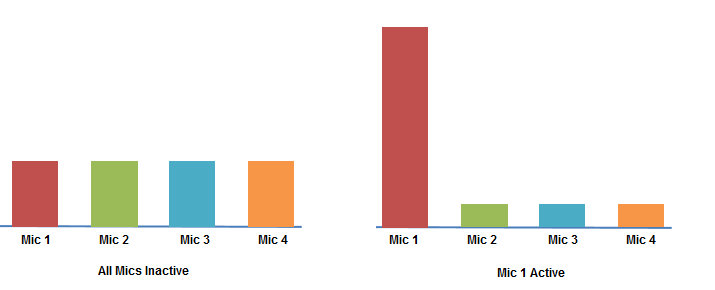Gain Sharing vs. Gating Automixer
This article provides a brief description of the Gain sharing and Gating Automatic Mixers, and provides advice on how to choose between them.
Gain Sharing Auto Mixer
Based on Dan Dugan's design, the Gain Sharing Auto Mixer as implemented in Tesira is an automatic microphone mixing process whereby the total gain of the system remains constant. Each individual input channel is attenuated by an amount, in dB, equal to the difference, in dB, between that channel’s level and the sum of all channel levels. The effect is that as a microphone becomes active, it receives more gain while the inactive channels' gain is reduced. No mic is completely gated or turned off fully during normal operation.

Gating Auto Mixer
As the name implies, a Gating Auto Mixer employs active noise gates to only allow active channels to go through and prevent inactive channels from contributing to the overall mix. A channel is considered active if its able to breach the threshold set for the noise gate. In Biamp's Gating Auto Mixers, this threshold is set automatically and dynamically based on constant scanning of the input channels for the highest RMS level using an adaptive algorithm called Automatic Threshold Sensing.
In the above example, all 3 mics are below the initial threshold and as such they are GATED OFF and do not contribute to the output of the Gated auto mixer. To be GATED ON, the Mic level needs to exceed the Initial threshold.
Mic 2 is now GATED ON as it has exceeded the initial threshold. This also means that the Gated Auto Mixer will now dynamically adjust the threshold to a new value to account for the increased level on Mic 2. Mic 1 and 3 have to cross this new threshold to come on.
Comparison
| Gain Sharing | Gating |
|---|---|
| All mics contribute to output, with most gain to active mic and least to inactive ones. | Only active mics contribute to output level, inactive mics are effectively off |
| No option to control number of open mics. All mics are active at all times. | Maximum number of open mics can be set with auto mixer setings. |
| Smoother transition from one mic to another for moving sources | As a source moves between mics, output may feel interrupted due to mics gating on/off |
| Since mics are always on, there is less chance of loss of first syllables or speech cutting out noticeably | Mic gating actions can be affected by high noise levels and marginal speech level, causing loss of first syllables or speech cutting out. |
| Available gain to active microphones decrease with increasing number of mics in a system1 | Maximum number of open mics is either fixed or can be set, Active mics always get the same gain irrespective of number of mics |
| Open mics ensure 'comfort noise' to far end in distance conferencing application | If all mics gate off due to inactivity, it can cause unnatural silence for the far end.2 |
1. Biamp Gain Sharing Algorithm features a 'Microphone Isolation Factor' which allows concentrating gain to active microphones only
2. 'Last Mic Hold' setting mitigates this issue, needs to be manually set.
Which to choose?
Both types of Auto Mixers will prove excellent in multi-microphone systems. So deciding which one to use may well come down to personal preferences. Having said that, generally when an acoustic environment appears "difficult" and requires more control, it might make more sense to use a Gating Auto Mixer. For a more natural sounding system, a Gain Sharing Auto Mixer might be a better choice.
And of course, first choice doesn't need to be the final one. Programmable audio DSPs afford us the luxury of trying out both options and going with what works best.

